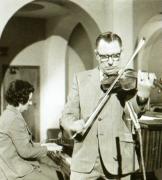|
|
||||||||||||||||||||||||
 |
Featured person
Recently added |
Robert Adrain (1775 - 1843): |
||||||||||||||||||||||
Robert Adrain was born near Carrickfergus, on 30 September 1775, the eldest of five children. His father had emigrated from France and was a schoolteacher and maker of mathematical instruments; his mother was of Scottish descent. He was fifteen when both parents died so to support himself and his siblings he opened a school in Ballycarry. Adrain had received a good education but which did not include any mathematics beyond arithmetic. His own curiosity, however, led him to study books on mathematics which explained algebraic notation and so he became essentially a self-taught mathematician In the 1798 he married Ann Pollock; he also joined the United Irishmen and participated in the Rebellion of that year; he was wounded in the back by friendly fire but managed to avoid capture and escaped with his wife and daughter to New York, settling in Princeton, New Jersey. He taught at Princeton Academy for two years, followed by a succession of positions, teaching mathematics. He was president of the York County Academy in York, Pennsylvania, from 1801 to 1805.
In 1805 he became principal of an academy in Reading, Pennsylvania, in 1809 a professor at Columbia in New York City and in 1826 he moved to the University of Pennsylvania where he remained until 1834, becoming Vice-Provost in 1828. He was asked to resign following discipline problems in his classes, probably caused by his tendency to irritability and sarcasm; he returned to New Brunswick where he earned his living tutoring privately until 1836 when again he went to New York, teaching at the Grammar School attached to Columbia College. In 1840 he retired and returned to New Brunswick where he spent the three years of his retirement before his death.
He is chiefly remembered for his formulation of the method of least squares, published in 1808. Adrain certainly did not know of the work of CF Gauss on least squares (published 1809), although it is possible that he had read AM Legendre's article on the topic (published 1806). Adrain, Gauss, and Legendre all motivated the method of least squares by the problem of reconciling disparate physical measurements; in the case of Gauss and Legendre, the measurements in question were astronomical, and in Adrain's case they were survey measurements.
Adrain was an editor of and a main contributor to the Mathematical Correspondent, the first mathematical journal in the United States, launched in 1804. Later he twice attempted to found his own journal, The Analyst, or, Mathematical Museum, but in both the 1808 and 1814 attempts it did not attract sufficient subscribers and quickly ceased publication. He was elected a Fellow of the American Academy of Arts and Sciences in 1813. In 1825 he founded a somewhat more successful publication targeting a wider readership, The Mathematical Diary, which was published until 1832.
In other work Adrain published two articles on the figure of the earth in 1818 in The Transactions of the American Philosophical Society and from 1811 edited several American editions of C Hutton's Course in Mathematics. He was elected to the American Philosophical Society in 1812 and the American Academy of Arts and Science in 1813. Adrain was considered one of the most brilliant mathematical minds of the time in America. His reputation might be even higher, but many of his papers were accidentally destroyed after his death, which occurred in New Brunswick. Of his seven children, a son was a Democratic Congressman, Garnett Bowditch Adrain.
On 29 May 2014 the Ulster History Circle unveiled a commemorative Blue Plaque at Carrickfergus Library.
| Born: | 1775 |
| Died: | 1843 |
| Richard Froggatt |
| Acknowledgements: Kate Newmann; Ulster History Circle |
| Bibliography: See also: http://www-groups.dcs.st-and.ac.uk/history/Biographies/Adrain.html (biographical article by J J O'Connor and E F Robertson) |


Home | Our Policies | Plaques | Browse | Search | Sponsors | Links | Help | Contact
Privacy & Disclaimer | Cookie Policy | Site Map | Website Design By K-Point
© 2024 Ulster History Circle









